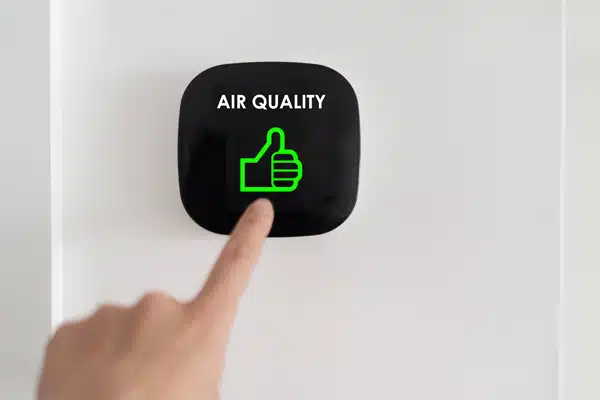3 Steps to Better Indoor Air Quality
One of the changes that resulted from the Covid-19 pandemic is a major interest in improving indoor air quality. If people were spending 90% of their time indoors, everyone would benefit from improved indoor air quality. If we face an unseen, airborne virus, how can we remove the virus to avoid the disease it causes? The sale of air quality monitoring and air cleaning technology has grown exponentially, up 800% since 2015.
Indoor Pollutant Sources. The building material of each home often contributes to indoor air quality. Older homes might contain harmful substances, such as asbestos or lead. Generally, these products are inert and do not become airborne unless disturbed during renovation. Newly manufactured items, including carpet and paint, release volatile organic compounds (VOCs), usually in the form of a gas.
Human activity also contributes pollutants to indoor air; just breathing adds CO2. The skin and hair of family members and pets add dust and dander. Cooking, smoking, cleaning, and lighting candles add gases to the indoor mixture of air. If you cook, heat water, and heat the air with natural gas or propane, the combustion contributes CO to the pollutant level.
Outdoor Pollutant Sources. The airborne particles in outdoor air are much more dilute since they move around a lot. The level of pollutants varies according to location and season. Organic particles include pollen, mold and mildew spores, and mites—microscopic insects that feed on organic dust particles. Pests, including both rodent and insect varieties, can contribute to indoor air pollution.
Let’s be clear; every home will contain some of these pollutants, but no home will contain all of these pollutants. It is important to first determine which pollutant category(categories) is the most troublesome in your living space.
Steps to Cleaner Indoor Air
1 Monitor Indoor Air Quality.
Do you have an indoor air quality (IAQ) problem? What type of pollutants contributes the most? Monitoring the air quality is the only way to define any IAQ issues. Most indoor spaces already utilize some IAQ monitors; smoke and CO detectors are examples. Examples of further monitoring devices include:
- Single Pollutant Monitors. If a space is known or suspected of high concentrations of a particular pollutant, find a sensor that measures the known particulate and monitors its presence continuously.
- Multi-pollutant Monitors. These sensors measure the concentration of several pollutants at once. They can be set to monitor particulates by size—10 microns to 2.5 microns, as well as monitor the presence of gases—VOCs or formaldehyde for example.
- Monitors are available for both commercial and residential spaces.
2 Source Identification.
When a pollutant is identified, the next step is to find the source of the pollutant; does it originate from an outdoor or an indoor source? There might be a hidden problem that monitoring exposes.
3 Source control.
Identifying the pollutant type leads to finding steps to reduce or eliminate the source of the pollutant. If particulate size suggests a problem with pollen, possible sources include open windows, a leaky building envelope, or shoes/coats that carry pollen into a space.
IAQ Solutions. The type and concentration of pollutant determine the necessary step(s) needed to mitigate the situation.
- Air Filters. Filters remove airborne particles, but cannot remove gaseous pollutants. Filters are semi-permeable barriers, with small holes that let air through but capture other items. They are rated by the size of the hole by a MERV rating—the larger the MERV number the smaller the hole. The best air filters are high-efficiency particulate air (HEPA) filters, that capture 99% of solid airborne particles.
Consult with your HVAC technician to determine the appropriate filter for your system. Most residential HVAC systems cannot utilize HEPA filters. Filters will need to be changed periodically, often every three months.
- Ultraviolet Light(UV). When you are in direct sunlight it is in your best interest to apply sunblock to your skin. The UV light from the sun damages the cell walls of your exposed skin, a condition we call sunburn. The same principle is used by adding UV light to the HVAC ductwork; the light damages the cell walls of bacteria, viruses, pollen, mold spores, and dust mites. The inert cells are readily captured by the air filter or collected during vacuuming/dusting.
- Air Purifiers. Both small, portable, and large-scale air purifiers are available for any size of space. Air purifiers draw indoor air through a multi-phase filtration system, including an activated charcoal filter. Charcoal contains small pockets that attract, collect, and keep gaseous odors and pollutants. Often, these filters can be manually cleaned, so maintenance is required. Neither air filters nor UV light can remove gases from the air.
- Bipolar Ionization (BPI). BPI is installed inside the ductwork of an HVAC system. Ions are atoms or molecules that have at least one too many or one too few electrons compared to a more elemental form of the same substance. PBI creates both positive and negative oxygen molecules and releases them into an indoor space. The benefit is these ions readily attach to airborne particles and change their chemical formulas. Ions attach to VOCs and formaldehyde, creating inert organic compounds that become dust. They attach to organic material, such as bacteria and pollen, damaging cell walls. They also are attracted to other oxygen molecules, exchanging electrons and forming stable oxygen molecules.
Continuous follow-up air quality monitoring will help you keep apprised of the IAQ so that solution methods can be re-implemented in a timely manner.
Have questions about Indoor Air Quality? We can help!
Schedule your free Indoor Air Quality consultation by calling AllCool AC & Heating at 281-238-9292 or contact us via email.
